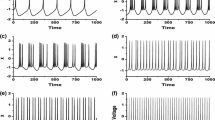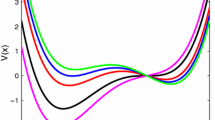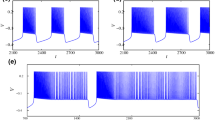Abstract
We introduce the concept of “type I burst excitability”, which is a generalization of the “normal” excitability that is well-known in cardiac and neural systems. We demonstrate this type of burst excitability in a specific model system, a pyramidal cell from the electrosensory lateral line lobe of the weakly electric fish Apteronotus leptorhynchus. As depolarizing current is increased, a saddle-node bifurcation of periodic orbits occurs, which separates tonic and burst activity. This bifurcation is responsible for the excitable nature of the system, and is the basis for the “type I” designation. We verify the existence of this transition from in vitro recordings of a number of actual pyramidal cells. A scaling relationship between the magnitude and duration of a current pulse required to induce a burst is derived. We also observe this type of burst excitability and the scaling relationships in a multicompartmental model that is driven by realistic stochastic synaptic inputs mimicking sensory input. We conclude by discussing the relevance of burst excitability to communication between weakly electric fish.
Similar content being viewed by others
References
Assad C, Rasnow B, Stoddard PK (1999) Electric organ discharges and electric images during electrolocation J. Exp. Biol. 202: 1185-1193.
Av-Ron E, Parnas H, Segel LA (1993) A basic biophysical model for bursting neurons. Biol. Cybern. 69: 87-95.
Bastian J, Chacron MJ, Maler L (2002) Receptive field organization determines pyramidal cell stimulus encoding capability and spatial stimulus selectivity. J. Neurosci. 22: 4577-4590.
Bastian J, Courtright J (1991) Morphological correlates of pyramidal cell adaptation rate in the electrosensory lateral line lobe of weakly electric fish. J. Comp. Physiol. A 168(4): 393-407.
Bastian J, Nguyenkim J (2001) Dendritic modulation of burst-like firing in sensory neurons. J. Neurophysiol. 85: 10-22.
Berman NJ, Maler L (1999) Neural architecture of the electrosensory lateral line lobe: Adaptations for coincidence detection, a sensory searchlight and frequency-dependent adaptive filtering. J. Exp. Biol. 202: 1243-1253.
Bub G, Shrier A, Glass L (2002) Spiral wave generation in heterogeneous excitable media. Phys. Rev. Lett. 88: 058101.
Butera RB, Clark JW, Byrne JH (1997) Transient responses of a modeled bursting neuron: Analysis with equilibrium and averaged nullclines. Biol. Cyber. 77: 307-322.
Butera RJ, Clark JW, Canavier CC, Baxter DA, Byrne JH (1995) Analysis of the effects of modulatory agents on a model bursting neuron: Dynamic interactions between voltage and calcium dependent systems. J. Comput. Neurosci. 2: 19-44.
Carr C, Maler L, Sas E (1982) Peripheral organization and central projections of the electrosensory nerves in gymnotiform fish. J. Comp. Neurol. 211: 139-153.
de Vreis G (1998) Multiple bifurcations in a polynomial model of bursting oscillations. J. Nonlinear Sci. 8: 281-316.
Doiron B, Laing CR, Longtin A, Maler L (2002) “Ghostbursting”: A novel bursting mechanism in pyramidal cells. J. Comput. Neurosci. 12(1): 5-25.
Doiron B, Longtin A, Turner RW, Maler L (2001a) Model of gamma frequency burst discharge generated by conditional backpropagation. J. Neurophysiol. 86(4): 1523-1545.
Doiron B, Noonan L, Lemon N, Turner RW (2003) Persistant Na+ current modifies burst discharge by regulating conditional backpropagation of dendritic spikes. J. Neurophysiol. 89: 324-337.
Doiron B, Noonan L, Turner RW, Longtin A, Maler L (2001b) Shifting burst threshold with dendritic conductances. XXXI Proc. Soc. Neurosci, San Diego.
Ermentrout GB (1996) Type I membranes, phase resetting curves, and synchrony. Neural Comp. 8: 979-1001.
Glass L, Mackey MC (1988) From Clocks to Chaos: The Rhythms of Life. Princeton University Press.
Goldbeter A (1996) Biochemical Oscillations and Cellular Rhythms: The Molecular Bases of Periodic and Chaotic Behaviour. Cambridge University Press.
Guckenheimer J, Holmes P (1990) Nonlinear oscillations, dynamical systems and bifurcations of vector fields. Applied Mathematical Sciences, Springer-Verlag, Vol. 42.
Gutkin BS, Ermentrout GB (1998) Dynamics of membrane excitability determine inter-spike interval variability: A link between spike generation mechanisms and cortical spike train statistics. Neural Comp. 10: 1047-1065.
Izhikevich EM (2000) Neural excitability, spiking, and bursting. Int. J. Bifn. Chaos 10: 1171-1266.
Keener J, Sneyd J (1998) Mathematical Physiology. Interdisciplinary Applied Mathematics, Vol. 8. Springer-Verlag, New York.
Koch C (1999) Biophysics of Computation: Information Processing in Single Neurons. Oxford University Press.
Kuznetsov YA (1995) Elements of Applied Bifurcation Theory. Applied Mathematical Sciences, Springer-Verlag, Vol. 112.
Laing CR, Doiron B, Longtin A, Maler L (2002) Ghostbursting: The effects of dendrites on spike patterns. Neurocomputing 44-46: 127-132.
Laing CR, Longtin A (2002) A two-variable model of somaticdendritic interactions in a bursting neuron. Bull. Math. Biol, 64: 829-860.
Lemon N, Turner R (2000) Conditional spike backpropagation generates burst discharge in a sensory neuron. J Neurophysiol 84: 1519-1530.
Lisman JE (1997) Bursts as units of neural information: Making unreliable synapses reliable. Trends Neurosci 20: 38-43.
Mainen ZF, Sejnowski TJ (1996) Influence of dendritic structure on firing pattern in model neocortical neurons. Nature 382: 363-366.
Metzner W (1999) Neural circuitry for communication and jamming avoidance in gymnotiform electric fish. J. Exp. Biol. 202: 1365-1375.
Metzner W, Heiligenberg W (1991) The coding of signals in the electric communication of the gymnotiform fish Eigenmannia: From electroreceptors to neurons in the torus semicircularis of the midbrain. J. Comp. Physiol. [A] 169: 135-150.
Nelson, ME, Xu Z, Payne JR (1997) Characterization and modeling of P-type electrosensory afferent responses to amplitude modulations in a wave-type electric fish. J. Comp. Physiol. A. 181: 532-544.
Pinsky PF, Rinzel J (1994) Intrinsic and network rhythmogenesis in a reduced Traub model for CA3 neurons. J. Comput. Neurosci. 1: 39-60.
Rinzel J, Ermentrout GB (1998) Analysis of neural excitability and oscillations. In: C Koch, I Segev, eds. Methods in Neuronal Modeling: From Ions to Networks. MIT Press.
Smith GD, Cox CL, Sherman SM, Rinzel J (2000) Fourier analysis of sinusoidally driven thalamocortical relay neurons and a minimal integrate-and-fire-or-burst model. J. Neurophysiol. 83: 588-610.
Steriade M, Timofeev I, Dürmüller N, Grenie F (1998) Dynamic properties of corticothalamic neurons and local cortical interneurons generating fast rhythmic (30-40 Hz) spike bursts. J. Neurophysiol. 79: 483-490.
Terman D (1992) The transition from bursting to continuous spiking in excitable membrane models. J. Nonlinear Sci. 2(2): 135-182.
Turner RW, Maler L (1999) Oscillatory and burst discharge in the Apteronotid electrosensory lateral line lobe. J. Exp. Biol. 202: 1255-1265.
Xu Z, Payne JR, Nelson ME (1996) Logarithmic time course of sensory adaptation in electrosensory afferent nerve fibers in a weakly electric fish. J. Neurophysiol. 76: 2020-2032.
Zupanc GKH, Maler L (1993) Evoked chirping in the weakly electric fish (Apteronotus leptorhynchus): Aquantitative biophysical analysis. Can. J. Zool. 71: 2301-2310.
Author information
Authors and Affiliations
Rights and permissions
About this article
Cite this article
Laing, C.R., Doiron, B., Longtin, A. et al. Type I Burst Excitability. J Comput Neurosci 14, 329–342 (2003). https://doi.org/10.1023/A:1023269128622
Issue Date:
DOI: https://doi.org/10.1023/A:1023269128622




